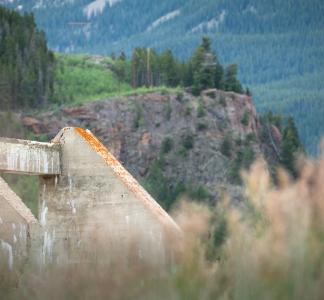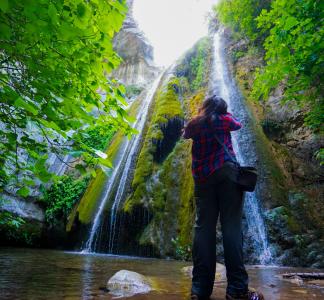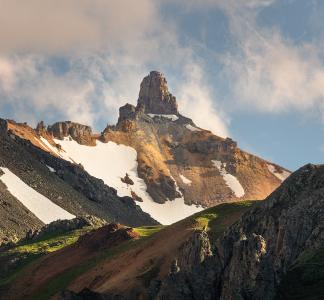Protecting iconic Colorado lands will move our nation one step closer to conservation goals

Ice Lake in the San Juan Mountains, Colorado
Jim Ramey, TWS
CORE Act a step toward goal of protecting 30% of our lands by 2030
We recognize Indigenous communities for their continuing stewardship of these lands, honor their sovereignty and respect their unique connections to and knowledge of these places. We are committed to being more conscientious and inclusive by working closely with Cheyenne, Pawnee, Arapaho, Osage, Ute, Apache and the innumerable Indigenous peoples and communities who have traditionally used these areas and who are connected to these lands to this day.
When I moved to Colorado nine years ago, one of the breathtaking mountain expanses that first welcomed me was the view of the Sneffels Range of the San Juan Mountains. Probably one of the most-photographed peaks in Colorado, Mt. Sneffels is the anchor to a still unprotected stretch of public lands in southwestern Colorado in the northern San Juan Mountains.

The Sneffels Range of the San Juan Mountains
Jim Ramey, TWS
What I didn’t know nine years ago is the impressive view, recreation opportunities, wildlife habitat and water resources before me in the San Juan range were at risk. Like so many other natural areas, much of the San Juan range is unprotected, aka open to mining, drilling and other development. We lose a football field worth of nature every 30 seconds in the United States, which further exacerbates the climate crisis.
Across the nation local communities are working together to help reverse that trend by protecting our last remaining wildlands. The San Juan Mountains are just one of the integral landscapes that must be protected for so many reasons, and the Colorado Outdoor Recreation & Economy Act, or CORE Act for short, is how we make that happen and help our nation reach the science-driven goal to protect 30% of our lands by 2030.
The CORE Act is decades in the making and one of the most broadly supported pieces of public lands legislation in a generation.
The CORE Act is decades in the making and one of the most broadly supported pieces of public lands legislation in a generation. It is championed by Senators Michael Bennet and John Hickenlooper, and Representative Joe Neguse, and our team here at TWS continue to work hard to ensure local voices are leading the effort to move this bill forward. It is the local communities that have the biggest stake in the game and these are the people who understand the land and the wildlife patterns in a way that others may not.
In working with our local partners and in my own journeys, I’m fortunate to have experienced first-hand many of the places that would be protected by the CORE Act. The CORE Act will have tremendous benefits for land, water, wildlife, and recreation in Colorado, but I want to share a few of my favorite places and photographs I have taken over the years to showcase some of the areas deserving of protection.
Thompson Divide
Rugged mountains, dense aspen stands and prime habitat for elk make up the heart of the Thompson Divide. The CORE Act would remove the threat of future oil and gas leasing and bring respite to the ranchers, water users, mountain bikers and conservationists who formed a coalition more than a decade ago to protect this place. As they say: “Unified for Thompson Divide!”

Old growth aspen stands along Clear Fork in the Thompson Divide, Colorado
Jim Ramey, TWS
A famed conservationist, and a Republican, exclaimed Thompson Divide as “a great, wild country.” President Theodore Roosevelt visited the area on a hunting expedition and marveled at the Divide’s “mountains crowded together in chain, peak, and tableland; all of the higher ones wrapped in an unrent shroud of snow.”

In addition to being vital for the agricultural economy of the region, the Thompson Divide is a destination for all kinds of recreation - including a snowy winter hike up Coal Creek Road.
Jim Ramey, TWS
Yet the Divide has been at risk for years targeted for new drilling and fracking for gas. The communities from Glenwood Springs to Carbondale and the North Fork Valley have rallied to protect this special place.
Continental Divide
The White River is our nation’s most visited National Forest, due in large part to the ski traffic in the forest’s many ski resorts. Increased development and visitation has strained wildlife habitat, stressing elk, mule deer and other animals. The CORE Act would protect about 70,000 acres across Colorado’s central mountains as new wilderness, recreation and wildlife conservation areas.

On a hike with Rep. Joe Neguse (fourth from right) along the Continental Divide Trail near Gold Hill trailhead.
Jim Ramey, TWS
One of the areas to be protected along the Continental Divide is Quandary Peak, one of Colorado’s famed 14ers - 14,000-foot peaks - and a popular destination outside Breckenridge. Under the CORE Act, the mountain would be protected as a mix of wilderness and recreation management.

A mountain goat along the trail to Quandary Peak in the Continental Divide, Colorado
Jim Ramey, TWS
Anyone who’s ever driven west on Interstate 70 from Denver up to the 11,112-foot Eisenhower Tunnel may not know that the land bridge over the tunnel is invaluable for wildlife looking to traverse north or south. There are not many other breaks in the east-west oriented highway for an elk to wander over. The CORE Act would protect this area for wildlife conservation.

The Porcupine Gulch Wildlife Conservation Area in the foreground, which would be protected under the CORE Act, looking East from the Divide Trail on the high-elevation land bridge over the Eisenhower Tunnel.
Jim Ramey, TWS
Camp Hale
Our modern day outdoor recreation economy and experience are in large part thanks to a group of American heroes who formed the Army’s 10th Mountain Division. The group trained in Colorado’s high country during WWII before going to valiantly fight and emerge victorious from Italy’s Apennine Mountains.

Camp Hale was once found along the valley floor where more than 1,000 buildings and 15,000 troops trained. The area would be protected as the Nation’s first ever National Historic Landscape under the CORE Act.
Jim Ramey, TWS
Curecanti National Recreation Area
Many may not know that the second-most visited unit of the National Park system in Colorado, but Curecanti offers hiking, boating, fishing, picnicking and camping for folks from across Colorado and the nation. Nearly 1 million visitors enjoy the shores, waves and trails of Curecanti each year.
Unlike most National Recreation Areas, Curecanti was oddly established through a Memorandum of Understanding between various federal agencies rather than an Act of Congress.

Cascades along the Curecanti Creek Trail in Curecanti National Recreation Area, Colorado
Jim Ramey, TWS
The CORE Act would also require the Bureau of Reclamation to fulfill its promise to restore 26 miles of fishing access in the Gunnison Basin, after considerable river and stream access was lost when the Blue Mesa Dam was completed in 1966.

The Dillon Pinnacles viewed from the Dillon Pinnacles Trail in Curecanti National Recreation Area, Colorado
Jim Ramey, TWS
San Juan Mountains
Perhaps Colorado’s most spectacular range of mountains, the San Juans, embody wildness. Its peaks are so spectacular, almost everyone wants to use images of Mt. Sneffels for the covers of reports.

Climbers along the southwest ridge route near the top of Mt. Sneffels in the San Juan Mountains, Colorado
Jim Ramey, TWS
The unifying thread that ties these areas together is the long-standing and broad support for permanent protection for these places. For the Coloradans in the communities working to pass this legislation, it has been a long mountain to climb. But once the bill is passed and signed into law, and these forests, streams and peaks are protected in perpetuity, it will be well worth the effort.

Clouds below the summit of Mt. Sneffels in th San Juan Mountains, Colorado
Jim Ramey, TWS
I chose to share some of the above photos in black and white in hopes they will inspire folks to find more time in our great outdoors. Find your park, find your trail and remember to leave no trace.
Colorado’s Camp Hale recognizes military history in wild setting
Mason Cummings, TWS
House votes to protect millions of acres of wilderness and other public lands in sweeping legislation
Darryl Vigil via Missy Adventures, Flickr
Protections for Colorado wilderness, wildlife, historic sites in new legislative proposal
Mason Cummings, TWS



